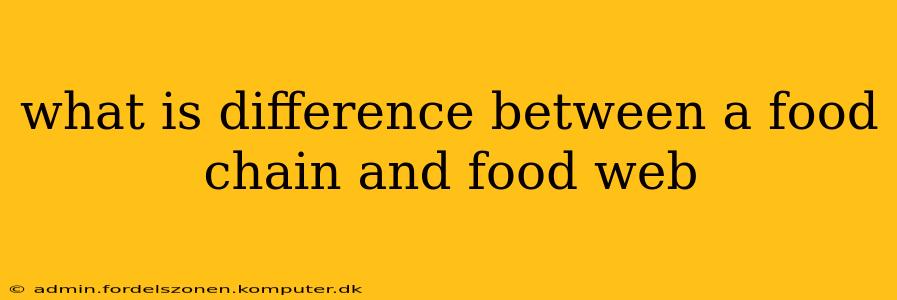What's the Difference Between a Food Chain and a Food Web?
Understanding the difference between a food chain and a food web is crucial to grasping the complexities of ecosystems. While both illustrate the flow of energy and nutrients in an environment, they differ significantly in their scope and representation.
A food chain is a linear sequence illustrating the transfer of energy and nutrients from one organism to another. It typically starts with a producer (like a plant), followed by a primary consumer (herbivore), a secondary consumer (carnivore that eats the herbivore), and potentially a tertiary consumer (carnivore that eats other carnivores). Think of it as a single, straightforward path of energy flow. For example:
- Sun → Grass → Grasshopper → Frog → Snake
This simple chain shows a direct, linear relationship. The snake only eats frogs, the frog only eats grasshoppers, and so on. It's a simplified representation of reality, however.
A food web, on the other hand, is a more complex and realistic depiction of energy flow. It shows interconnected food chains, demonstrating the multiple feeding relationships within an ecosystem. Instead of a single path, it shows a network of interconnected paths. Organisms often have multiple food sources and are prey to multiple predators. This interconnectedness creates a more nuanced picture of the ecosystem's stability and resilience.
Imagine our previous example expanded:
- Sun → Grass → Grasshopper → Frog → Snake
- Sun → Grass → Rabbit → Fox
- Sun → Grass → Mouse → Owl → Snake
- Sun → Flowers → Bee → Frog
Now we see that the frog eats both grasshoppers and bees, the snake eats both frogs and mice, and the fox and owl have their own prey. This intricate web highlights the interdependence of organisms and the cascading effects if one species is removed or impacted.
What are some other key differences?
Here are some key differences summarized:
- Complexity: Food chains are simple, linear sequences; food webs are complex, interconnected networks.
- Representation: Food chains represent a single path of energy transfer; food webs represent multiple interconnected paths.
- Realism: Food chains are simplified models; food webs provide a more realistic representation of ecosystem dynamics.
- Stability: The interconnectedness of a food web makes it more stable than a simple food chain; disruption in one part of the web may be buffered by other pathways.
How are food chains and food webs used?
Both food chains and food webs are valuable ecological tools used to:
- Understand energy flow: Both illustrate how energy moves through an ecosystem, highlighting the trophic levels (producer, consumer, decomposer).
- Identify keystone species: A keystone species is one that plays a disproportionately large role in its ecosystem. Food webs help identify these pivotal organisms.
- Model ecosystem impacts: By analyzing food webs, scientists can predict the impact of environmental changes or species introductions/extinctions.
- Educate: They are simplified ways to teach about ecological relationships in a comprehensible manner.
In essence, while a food chain provides a basic understanding, a food web offers a more complete and accurate picture of the complex interactions within an ecosystem. They both serve as important tools for ecologists and anyone interested in understanding the intricate balance of nature.
